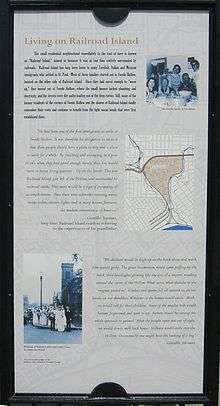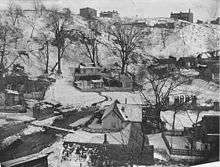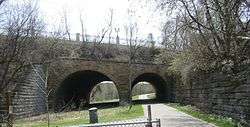Swede Hollow, Saint Paul
Coordinates: 44°57′37″N 93°04′34″W / 44.9603°N 93.0760°W[1]

Swede Hollow was a neighborhood of St. Paul, Minnesota. It was one of a large group of neighborhoods collectively known as the East Side, lying just to the east of the near-downtown Railroad Island neighborhood, and at the northwestern base of Dayton's Bluff. It was capped in the north by the sprawling Hamm's Brewery (with its imposing Hamm family mansion), and in the south by the historic Seventh Street Improvement Arches. Although one of the oldest settlements in the city, it was also arguably the poorest as each wave of immigrants settled in the valley.[2] Swedes, Poles, Italians and Mexicans all at one point called the valley home. A similar community just downstream called Connemara Patch also existed for Irish immigrants.
History
Originally the area was a small, steep, wooded ravine cut through by Phalen Creek. The first settler, Edward Phelan, moved there in 1841. Phelan fled Minnesota in 1850 after perjury charges arose but not before being leaving a mark that would change what was once Mill Creek to Phalen.[3][4] Among the earliest inhabitants to settle permanently in the isolated spot were Swedish immigrants. First arriving in the 1850s, they gave their new home the name "Svenska Dalen," a designation that remained (in English translation) long after the original settlers had moved on, to be replaced by a wave of Italian immigrants in the early 20th century. At the time of the neighborhood's demise in the mid-fifties, it had attracted a collection of Mexican families as well.

Although remembered with a certain sense of nostalgia today, it is not an exaggeration to describe the former area as a true slum. People and industries occupying the surrounding "upper" neighborhoods used the Hollow as a makeshift dump, which the inhabitants down below routinely scavenged for clothing, metals, building supplies, and even shoe repair needs.[5] Several gristmills operated on the creek by the 1850s. In addition, railroad tracks were built along the creek in 1865, because the creek bed provided an easier grade up from the Mississippi River than bluffs in other places.[3]
Quite remarkably for a neighborhood in the heart of a major American city in the mid-20th century (especially given the Twin Cities region's challenging climate), Swede Hollow was never electrified, and plumbing conditions were extremely primitive. The residences were constructed almost entirely out of recovered and scrapped building materials, and the entire affair was serviced by a single meandering dirt road. Toilet facilities consisted of outhouses constructed directly over Phalen Creek. The original inhabitants of Swede Hollow got their water from springs and used Phelan Creek as their sewer, leading to water and sanitation problems.[6]
Destruction
So squalid were the conditions of the Hollow, in fact, that in 1956 the city declared the entire neighborhood a health hazard. The last remaining families were forcibly evicted, and the entire housing stock was burnt to the ground on December 11 of the same year. At one time (1905) as many as 1,000 people called the tiny little glade their home, although there were far fewer (14 families in all) remaining at the time of the December 11, 1956 clearing.[3][7]
Today
Soon after the destruction the area became a dumping ground and gathering place for the homeless. In the 1970s the valley was cleaned up, and it was designated a nature center in 1976. A 1917 report remarked, "Phalen Creek and the banks of this stream are ideal for park purposes, while in their present state they constitute a menace to the health of the residents and to the community at large."[7] The area remains uninhabited to this day. The original woodland state has returned (although some of the building foundations still remain), the creek has been partially restored, and the entire valley has been made part of Swede Hollow Park, a city park. The trail running along the west edge of Swede Hollow is the Bruce Vento Regional Trail, paved on the former right-of-way of the Northern Pacific Railway's Skally Line that ran from St. Paul to Duluth.[3]
The award-winning album Minnesota: A History of the Land, released by musician Peter Ostroushko in 2005, included a piece called "Swede Hollow Lament".[8] In 2012 composer Ann Millikan premiered an opera about Swede Hollow.[9]
Connemara Patch

Just south and downstream of Swede Hollow was a lesser-known Irish neighborhood called Connemara Patch. It was so named after the original home of its Irish settlers, who arrived in the United States under the sponsorship of Archbishop John Ireland, who settled them on prairie claims near Graceville, Minnesota. When the original rural colonization plan was aborted by the long, blizzard-wracked winter of 1880 (a season so harsh it was immortalized in the Laura Ingalls Wilder book The Long Winter), the desperate immigrants were resettled along lower Phalen Creek in the area between East Seventh and East Fourth streets as a stopgap measure—one that ultimately became permanent. The legendary Irish-language storyteller Éamon a Búrc spent several years in the district before a railroad accident took his leg, leading him to return to his village in County Galway, Ireland.[10][11][12]
Like Swede Hollow, Connemara Patch was eventually cleared of its inhabitants. The neighborhood's remnants were completely destroyed by urban renewal in the 1950s. Interstate 94 currently occupies a substantial portion of the old enclave. The rest of the site is largely vacant, except for a few dilapidated industrial structures.[7]
References
- ↑ Swede Hollow Park, St. Paul, MN. Google Earth. Retrieved 2011-03-14.
- ↑ Lost Twin Cities 2: Swede Hollow Twin Cities Public Television
- 1 2 3 4 Millett, Larry (2007). AIA Guide to the Twin Cities: The Essential Source on the Architecture of Minneapolis and St. Paul. Minnesota Historical Society Press. p. 385. ISBN 0-87351-540-4.
- ↑ Kunz, Virginia Brainard. Saint Paul: The First One Hundred and Fifty Years. Bookmen. pp. 15–16. ISBN 0-9630690-0-4.
- ↑ Part I: The Great Depression in Swede Hollow, by Michael T. Sanchelli Minnesota Historical Society
- ↑ "Swede Hollow Continues Immigrant Tradition with a Focus on Water". Minnesota Department of Health. 24 Jan 2007. Retrieved August 28, 2009.
- 1 2 3 L. Empson, Donald (2006). The Streets Where You Live. University of Minnesota Press. pp. 60, 262–263. ISBN 0-8166-4729-1.
- ↑ Minnesota: A History of the Land. wikipedia.org. Retrieved: November 5, 2012.
- ↑ Schouweiler, Susannah (4 June 2012), ‘Swede Hollow’ is the subject of a new opera and the site of its premiere
- ↑ Kunz, Virginia Brainard. Saint Paul: The First One Hundred and Fifty Years. Bookmen. p. 57. ISBN 0-9630690-0-4.
- ↑ Regan, Ann (2002). Irish in Minnesota. St. Paul, MN: Minnesota Historical Society Press. pp. 22–23. ISBN 0-87351-419-X.
- ↑ Binchy, Maeve; O'Donoghue, Jo (2004). Brewer's dictionary of Irish phrase & fable. London: Weidenfeld & Nicholson. p. 393. ISBN 0-304-36334-0.
External links
| Wikimedia Commons has media related to Swede Hollow. |
| Wikimedia Commons has media related to Seventh Street Improvement Arches. |
- Swede Hollow Park at Placeography
- From Swede Hollow to Arlington Hills
- Swede Hollow Continues Immigrant Tradition with a Focus on Water
- Friends of Swede Hollow
Minnesota Historical Society
- Swede Hollow photos
- Swede Hollow artwork
- I Remember St. Paul's Swede Hollow
- Swede Hollow in MNopedia, the Minnesota Encyclopedia
Videos
Connemara Patch at the MHS